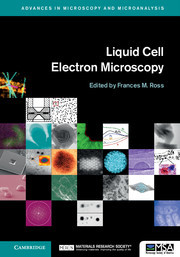Description
Liquid Cell Electron Microscopy
Advances in Microscopy and Microanalysis Series
Coordinator: Ross Frances M.
The first book on the topic, covering the fundamental theory, applications, and future developments of liquid cell electron microscopy.
Language: English
Subject for Liquid Cell Electron Microscopy:
Publication date: 11-2016
524 p. · 17.7x25.5 cm · Hardback
524 p. · 17.7x25.5 cm · Hardback
Description
/li>Contents
/li>Biography
/li>
The first book on the topic, with each chapter written by pioneers in the field, this essential resource details the fundamental theory, applications, and future developments of liquid cell electron microscopy. This book describes the techniques that have been developed to image liquids in both transmission and scanning electron microscopes, including general strategies for examining liquids, closed and open cell electron microscopy, experimental design, resolution, and electron beam effects. A wealth of practical guidance is provided, and applications are described in areas such as electrochemistry, corrosion and batteries, nanocrystal growth, biomineralization, biomaterials and biological processes, beam-induced processing, and fluid physics. The book also looks ahead to the future development of the technique, discussing technical advances that will enable higher resolution, analytical microscopy, and even holography of liquid samples. This is essential reading for researchers and practitioners alike.
Part I. Technique: 1. Past, present and future electron microscopy of liquid specimens Niels de Jonge and Frances M. Ross; 2. Encapsulated liquid cells for transmission electron microscopy Eric Jensen and Kristian Mølhave; 3. Imaging liquid processes using open cells in the TEM, SEM, and beyond Chongmin Wang; 4. Membrane based environmental cells for SEM in liquids Andrei Kolmakov; 5. Observations in liquids using an inverted SEM Chikara Sato and Mitsuo Suga; 6. Temperature control in liquid cells for TEM Shen J. Dillon and Xin Chen; 7. Electron beam effects in liquid cell TEM and STEM Nicholas M. Schneider; 8. Resolution in liquid cell experiments Niels de Jonge, Nigel Browning, James E. Evans, See Wee Chee and Frances M. Ross; Part II. Applications: 9. Nanostructure growth, interactions and assembly in the liquid phase Hong-Gang Liao, Kai-Yang Niu and Haimei Zheng; 10. Quantifying electrochemical processes using liquid cell TEM Frances M. Ross; 11. Application of electrochemical liquid cells for electrical energy storage and conversion studies Raymond R. Unocic and Karren L. More; 12. Applications of liquid cell TEM in corrosion science See Wee Chee and M. Grace Burke; 13. Nanoscale water imaged by liquid cell TEM Utkur Mirsaidov and Paul Matsudaira; 14. Nanoscale deposition and etching of materials using focused electron beams and liquid reactants Eugenii U. Donev, Matthew Bresin and J. Todd Hastings; 15. Liquid cell TEM for studying environmental and biological mineral systems Michael H. Nielsen and James J. De Yoreo; 16. Liquid STEM for studying biological function in whole cells Diana B. Peckys and Niels de Jonge; 17. Visualizing macromolecules in liquid at the nanoscale Andrew C. Demmert, Madeline J. Dukes, Elliot Pohlmann, Kaya Patel, A. Cameron Varano, Zhi Sheng, Sarah M. McDonald, Michael Spillman, Utkur Mirsaidov, Paul Matsudaira and Deborah F. Kelly; 18. Application of liquid cell microscopy to study function of muscle proteins Haruo Sugi, Shigeru Chaen, Tsuyoshi Akimoto, Masaru Tanokura, Takuya Miyakawa and Hiroki Minoda; Part III. Prospects: 19. High resolution imaging in the graphene liquid cell Jungwon Park, Vivekananda P. Adiga, Alex Zettl and A. Paul Alivisatos; 20. Analytical electron microscopy during in situ liquid cell studies Megan E. Holtz, David A. Muller and Nestor J. Zaluzec; 21. Spherical and chromatic aberration correction for atomic-resolution liquid cell electron microscopy Rafal E. Dunin-Borkowski and Lothar Houben; 22. The potential for imaging dynamic processes in liquids with high temporal resolution Nigel D. Browning and James E. Evans; 23. Future prospects for biomolecular, biomimetic and biomaterials research enabled by new liquid cell electron microscopy techniques Taylor Woehl and Tanya Prozorov.
Frances M. Ross is based at IBM's T. J. Watson Research Center, where she has built a program around a microscope with deposition and focused ion beam capabilities, and developed closed liquid cell microscopy to image electrochemical processes. Previously she worked at the National Center for Electron Microscopy, Lawrence Berkeley National Laboratory, and has also been a Visiting Scientist at Lunds Universitet, Sweden and an Adjunct Professor at Arizona State University. She received the UK Institute of Physics Boys Medal, the MRS Outstanding Young Investigator Award and the MSA Burton Medal, holds an Honorary Doctorate from Lunds Universitet, and is a Fellow of the American Physical Society, the American Association for the Advancement of Science, the Materials Research Society, the Microscopy Society of America and the American Vacuum Society.
© 2024 LAVOISIER S.A.S.



